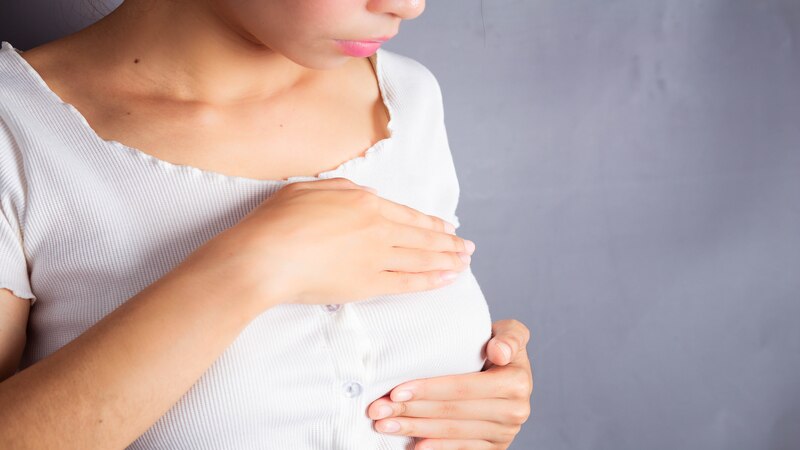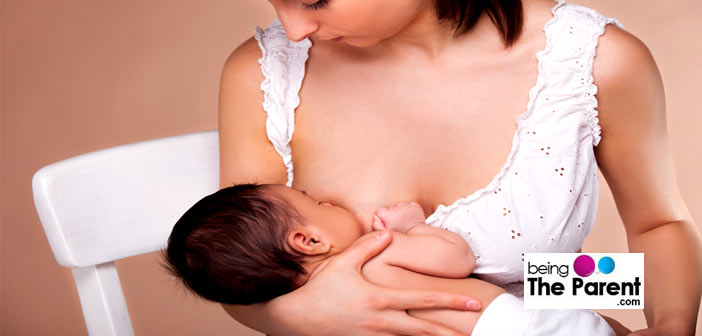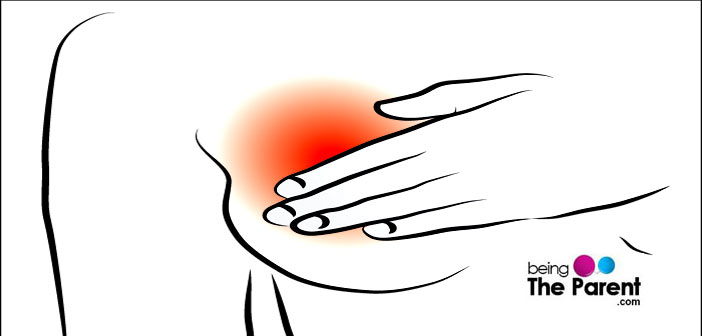
Generally affected on one breast at a given time, mastitis is inflammation of the tissue in the breast due to infection or blocked milk ducts. Though it does not pose a threat to a breastfed, baby, it could be painfully sore for the mother to breastfeed the baby if she is infected with mastitis. Bacteria thrive on the inflamed tissue, making feeding very difficult for the breastfeeding mother.
Though it can strike anytime between the period of two years after giving birth (and if you are breastfeeding) to a baby, mothers are more likely to develop this infection during the first 6 months.
- What Causes Mastitis?
- Symptoms Of Mastitis
- Mastitis While Breast-Feeding
- Making breastfeeding easier with mastitis
- Antibiotics For Mastitis
- Treating Mastitis
- How Can I Get Relief From Mastitis?
- Complications Of Mastitis
What Causes Mastitis?
Mastitis is primarily caused by milk build up in one or both breasts because milk is produced faster than it is eliminated from them. (Read about hyperlactation here). The stasis of milk is seen to occur when the baby does not take sufficient milk from the breasts or in other words the baby does not latch adequately on breasts. The obvious result is engorgement and stasis of milk and finally mastitis. (Read more about latching a baby here.
Other important causes are:
- Pressure on breasts due to tight fitting bra strap
- Any injury to breasts
- Milk engorgement due to excessive production and insufficient latching by baby
Symptoms Of Mastitis
Symptoms of mastitis include fever that comes and goes, you can feel shivering or hot any time. Plus, if you have mastitis you might feel rough with a continuous back ache and even a headache. Your breasts will feel hard and it can be very painful to nurse your baby. Appearance of bruise like red patches and lumps are also seen. There are other infections like tonsillitis, ear infection etc., that can be confused with mastitis. Make sure to get an appointment with your doctor and get checked. If you have fever it is always better to show a doctor, do not put you and yours child’s health at risk.
Some other signs of mastitis are:
- Redness in the breast area
- Swelling in breasts
- Hardness or lump in breasts
- Painful breasts
- Painful swollen lymph nodes in armpit close to the affected breast
- Fast heart rate

Mastitis While Breast-Feeding
Mastitis or breast inflammation is chiefly caused because of an bacterial infection. Women in general are vulnerable to mastitis, but breast feeding mothers are more prone to develop mastitis during first 6 months of childbirth. Being a first time mother makes you more susceptible to mastitis.
Mastitis renders a mother tired and drained off and owing to her illness, she is unable to look after her child properly. One should not stop feeding the baby because as a matter of fact, breast-feeding helps in eliminating the infection and will in no way harm your baby.
Breasts feeding mothers are more vulnerable to mastitis if she-
- Skips or delays breastfeeding sessions
- Has cracked nipples caused due to bad or improper latching
- Has anemia as it reduces body’s resistance to wade off invading infection
Making breastfeeding easier with mastitis
- If you are having mastitis, then before feeding your baby, keep a warm wet clean cloth on the painful breast for 10 to 15 minutes
- This will enhance the milk flow from the affected breast and will ease the pain
Antibiotics For Mastitis
Mastitis can be treated with antibiotics. But take them only when directed by a qualified doctor. Take the complete advised course and do not stop simply because you start feeling better. Antibiotics do not cause any harm to your baby so do not panic.
If mastitis is not improving even after the use of antibiotics, then your doctor will ask you to send the breast milk to laboratory for the identification of infecting bacteria. If fever is present take acetaminophen or ibuprofen. These are safe for kids and will help in reducing inflammation.
Treating Mastitis
The treatment should be started as soon as a lump is felt in breast or as soreness is felt in breast. Here is a gist of curative measures that should be done:
- Gently drain the breasts; the breasts should be keep empty as much as possible. Feeding the baby is the right thing to do as the milk is safe for him/ her
- Check whether your baby is getting milk. If the let down reflex is working properly as the baby starts to suck. You will experience a tingling sensation in breasts and a sudden feeling of fullness in breasts. The milk from the other breast begins to leak. The baby begins to gulp more often. You will become more relaxed, composed and the pain diminishes
- Wear a loose bra and take it off while feeding
- Relax while feeding the baby
- Take deep breaths
- Listening to soothing music and think about your baby
- Massage breasts by gently stroking towards nipples
- Apply gentle pressure behind the lump area
- Apply warm and cold compress
- Warmth can be gained by having a warm shower, immersing affected breasts in warm water bath
- Apply cold packs on the affected area to relive pain and swelling
- Change your feeding position to aid the shift in milk blockage

How Can I Get Relief From Mastitis?
Take a bath with hot water. Massage your breasts in circular motion on sore spots for some relief. Running hot water in your breast can make you feel good, express some milk from your breast. Do not handle your breast roughly while massaging them and nurse your baby frequently. Take prescribed antibiotics from your doctor. Don’t take any antibiotic directly from a drug store, some antibiotics can make you feel nauseated. If you do not get relief within 24 hours see a doctor.
Relief can be achieved by adopting the following steps:
- Make sure you baby is feeding well on your breasts
- Breastfeed baby as often as he/she wants
- Do not put off feeds
- Rest adequately
- Do not levy pressure on breasts either with some clothing or fingers
- Do not feed your baby on anything else except breastmilk
Complications Of Mastitis
The dire consequences of breast inflammation are enlisted as under-
- Stasis of milk-Mastitis causes pain in breasts and the mothers are tempted to halt breastfeeding. This result in accumulation of milk in affected breasts-called the stasis of milk
- Hardness in breasts-If mastitis is left untreated the breasts becomes hard
- Blocked milk ducts- This is a serious complication of mastitis
- Breast abscess
Very often, women get confused with engorgement to mastitis. Sometimes engorgement can also cause light fever, but it is not as severe as the fever you get in mastitis (101F). To find out if you have mastitis or not run a touch test on your breast. Your breast will feel hard, lumpy, and hot to touch, some redness will also appear on them. In case of mastitis, you may feel sore in your breasts after nursing. Make sure that you just don’t check the upper surface for redness, but under the breasts too. Sometimes the upper appearance seems to be all right, that’s why it is necessary to check yourself or ask someone to check for unusual redness and lumps in the breasts. The redness that appears on breast seems like a bruise but it is extremely agonizing.

